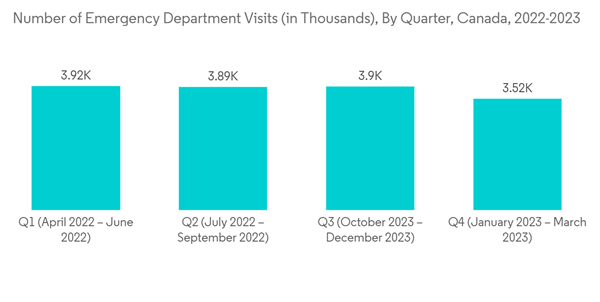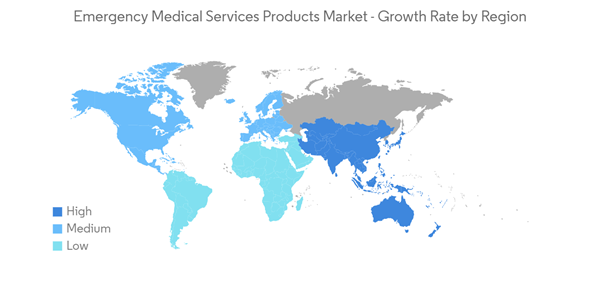Key Highlights
- The COVID-19 pandemic significantly impacted the emergency medical services (EMS) products market during the early phase of the pandemic. For instance, as per the article published by the PLOS One Journal in March 2022, the high incidence of COVID-19-related respiratory failure led to shortages in the supply of mechanical ventilators worldwide. Therefore, the shortages of ventilators during the pandemic showed the significant impact of the COVID-19 pandemic on the emergency medical services products market.
- However, by that time, the market had picked up its pace due to the increased awareness of the importance of preparedness and the need for robust medical infrastructure. Additionally, the market will likely experience sustained demand for advanced respiratory support devices and other emergency medical products to enhance emergency response capabilities and ensure adequate healthcare delivery during the post-pandemic period.
- The major factors driving the market growth include the rising incidence of chronic diseases and injuries, advancements in medical technology, and a surging number of product launches by prominent players.
- The rise in road accidents and trauma cases necessitates the availability of advanced EMS products for effective emergency care and management, thereby augmenting market growth. For instance, as per the report published by the Ministry of Road Transport and Highways of India (MoRTH) in December 2022, approximately 412,432 road accidents were reported in India in 2021, with injuries to 384,448 persons. Hence, the high frequency of road accidents in India is projected to drive the demand for emergency medical services products such as trauma kits, medical supplies, and specialized equipment needed for prompt and effective emergency response.
- In addition, the rising number of Emergency Department (ED) visits in various countries is also projected to drive the demand for life support & emergency resuscitation patient handling systems during the forecast period. For instance, according to the data published by the Australian Institute of Health and Welfare in October 2022, there were around 8.79 million visits to EDs in Australian public hospitals during 2021-2022. The same source mentioned that the ED visits in Australia were approximately 339 visits per 1,000 population during 2021-2022.
- Moreover, the prominent players are doing various strategic collaborations or partnerships to bring advanced emergency medical services products to the market. For instance, in August 2022, United Kingdom-based wheelchair manufacturer RGK and Sunrise Medical North America collaborated to launch RGK's new window Octane Sub4, a rigid titanium wheelchair.
- Therefore, the rising number of road accidents, increase in ED visits in various countries, and spur in the number of collaborations amongst prominent players to launch advanced EMS products are projected to drive market growth during the forecast period. However, the high cost of EMS products and stringent regulatory requirements are projected to restrain market growth during the forecast period.
Emergency Medical Services Products Market Trends
Ventilators Segment is Expected to Show Significant Growth Over the Forecast Period
- Ventilators play a vital role in emergency medical departments by providing life-saving life support to patients in critical conditions. The major factors driving the segment growth include the increase in critical respiratory conditions such as acute respiratory distress syndrome (ARDS), chronic obstructive pulmonary disease (COPD), pneumonia, surging government initiatives and investments, and a rising number of product launches by prominent players. For instance, as per the data released by the Government of the UK in April 2021, approximately 1,152,272 people were suffering from COPD in England in 2021. Hence, the rising number of people suffering from COPD is projected to accelerate the demand for ventilators during the forecast period.
- Furthermore, the rising government funding to improve healthcare infrastructure worldwide contributes to market growth. For instance, in March 2022, the Australian government invested USD 132 billion in 2022-2023 and is expected to invest about USD 140 billion in 2025-26, with a total commitment of USD 537 billion over the next four years, including USD 7.3 billion increase in Medicare funding, USD 9.8 billion increase in Hospital funding and USD 10.1 billion increase in Aged Care funding as compared to 2021-2022 budget. Such initiatives are anticipated to fuel the production of advanced EMS products, propelling the market growth.
- Moreover, prominent players' rising number of product developments is also increasing the market growth. For instance, in January 2023, Getinge AB launched its new Servo-c mechanical ventilator that offers lung-protective therapeutic tools for pediatric and adult patients.
- Therefore, due to the high prevalence of COPD, rising government funding, and surging number of product developments, the segment is expected to grow significantly during the forecast period.
North America is Expected to Hold the Significant Share of the Market Over the Forecast Period
- North America is expected to hold a significant market share over the forecast period due to the increasing number of emergency department (ED) visits, high healthcare expenditure, and the presence of various prominent players in the region.
- The rising number of ED visits in the region due to various emergency situations is projected to drive the demand for EMS products during the forecast period. For instance, as per the data published by the Canadian Institute for Health Information in February 2023, the total number of reported ED visits rose to around 14.0 million in Canada during 2021-2022, compared to 11.7 million in the previous year.
- Furthermore, the surge in the number of fatal injuries in the region also led to an increase in ED visits, thereby driving the market growth. For instance, according to the data released by the United States Bureau of Labor Statistics in December 2022, fatal work injuries in the United States reached 5,190 in 2021 compared to 4,764 in the previous year. Thus, such statistics indicate the increasing number of ED visits in the country, which is burgeoning the regional market growth.
- Furthermore, the presence of prominent players in the region and their active participation in launching advanced EMS products is also increasing the market growth. For instance, in May 2022, Invacare Corporation launched the Birdie Evo XPLUS lift in the United States.
- Therefore, the North American EMS market is expected to grow significantly due to the spur in the number of ED visits, increase in the incidence of fatal work injuries, and rising number of product launches.
Emergency Medical Services Products Industry Overview
The Emergency Medical Services Products market is moderately competitive due to a limited number of companies that manufacture and distribute EMS products. The market players are actively involved in product launches, collaborations, and acquisitions to uphold their position, including Bound Tree Medical, McKesson Corporation, Stryker Corporation, ICU Medical, Inc. (Smith Medical), and Cardinal Health, among others.Additional Benefits:
- The market estimate (ME) sheet in Excel format
- 3 months of analyst support
This product will be delivered within 2 business days.










